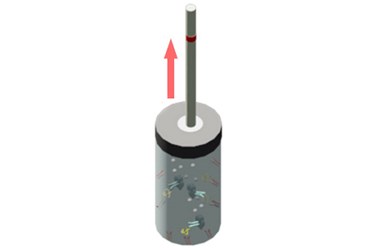Thermometer-Like Device Offers Point-Of-Care Heart Attack Diagnosis

Scientists have developed a handheld device that can determine whether or not someone is having a heart attack by measuring the level of troponin in the blood. Current tests for troponin are expensive and bulky, and the researchers believe that a small point-of-care device could provide earlier diagnosis and intervention in areas where access to hospital technology is limited.
The CDC estimates that 735,000 Americans per year suffer from a heart attack, and experts agree that early diagnosis is the key to ensuring patient survival. Though tell-tale physical symptoms can be highly accurate early indicators of a cardiac event, a heart attack is diagnosed conclusively in a hospital using an EKG or, in some cases, a test to check for elevated levels of a protein called troponin.
According to an American Chemical Society press release, a team of Korean scientists led by Sangmin Jeon noted that troponin levels tend to rise when blood flow to the heart is restricted or blocked and the heart muscle has sustained damage. Their goal, said Jeon, was to design a device that could be portable and inexpensive and practical for point-of-care use in areas with few medical resources.
The team's current design, described in a study published in Analytical Chemistry, was inspired by mercury/alcohol thermometers and is made of equally common and inexpensive materials. First, they loaded dendritic platinum nanoparticles with troponin antibodies that could capture the protein in a human serum sample. Next, they mixed the serum sample with the nanoparticles, and the vial was sealed with a screw cap with a silicon septum. Once the reaction occurs, a thin capillary tube containing a single drop of ink is pushed through the septum, and pressure caused by reactions within the vial cause the ink drop will rise. Scientists can then determine the concentration of troponin in the human serum sample by gauging how far the ink drop has risen.
According to the study, “The sensitivity of this assay for troponin I (TnI) in human serum after a five minute dissociation reaction, detected with the naked eye, was 0.1 ng/mL, which was better than the sensitivity of the conventional colorimetric method using TMB [3,3’,5,5’-Tetramethylbenzidine] oxidation reaction under the same experimental conditions.”
The team ran control experiments with similar proteins such as alpha-fetoprotein, interleukin-5, and C-reactive protein and found that the assay was highly selective for TnI alone.
According to the CDC, 47 percent of sudden cardiac deaths in the United States occur outside of the hospital, and the Korean team reported in their press release that three quarters of deaths related to cardiovascular disease occurred in low- to middle-income countries. The team hopes that their device can be further developed to provide better access worldwide to early heart attack diagnosis.
“This simple and cost-effective method may be especially beneficial for people in underdeveloped countries,” said the study authors.
Image credit: American Chemical Society
